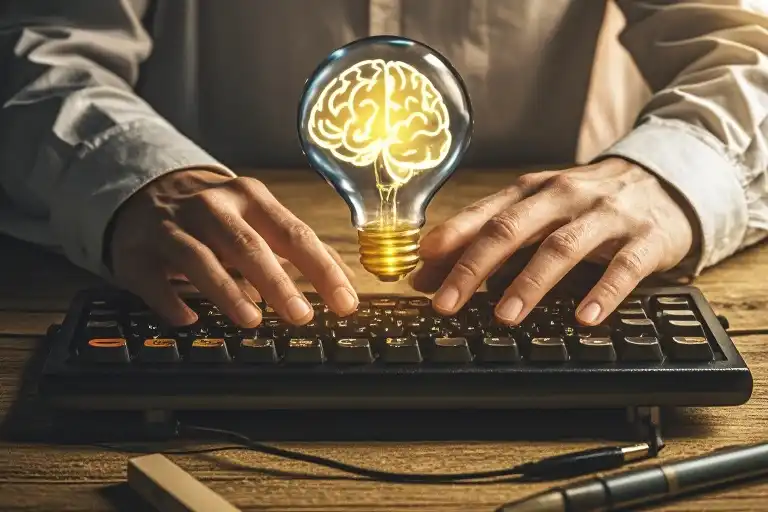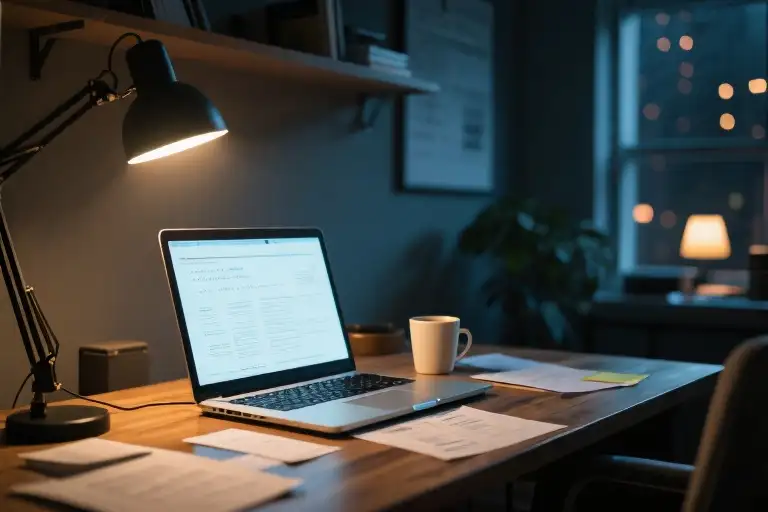The steam from my morning coffee curls upward in the quiet kitchen, carrying that familiar earthy aroma that promises either productivity or escape. On the wooden table before me sit two portals to different worlds – a dog-eared copy of Marcus Aurelius’ Meditations and my sleek, perpetually hungry laptop. Their silent confrontation mirrors the daily dilemma of every knowledge worker in our age: the book whispering promises of timeless wisdom, the screen pulsating with urgent possibility.
This isn’t just about choosing how to spend the next hour. It’s a fundamental conflict between two modes of thinking, two ways of being. The computer, with its infinite tabs and notifications, represents the fragmented attention economy we’ve all been conscripted into. The book remains one of humanity’s last bastions of linear, uninterrupted thought – if we can resist the siren call of the glowing rectangle long enough to turn its pages.
Neuroscience confirms what our distracted hearts already know: the human brain wasn’t designed for this digital-age juggling act. That comforting myth of multitasking? A cognitive illusion. When we attempt to split our focus between programming and prose, between debugging and Dostoevsky, we’re not actually doing both – we’re rapidly toggling between them with pitiful inefficiency. Each switch exacts a tax psychologists call ‘attention residue,’ leaving us with the sensation of busyness but little substantive progress in either domain.
I learned this the hard way during my own ill-fated experiments in dual-domain mastery. There was the month I tried annotating Proust while writing Python scripts, only to produce mediocre code and retain nothing of the French novelist’s delicate observations. The week I scheduled ‘algorithm practice’ alongside Nietzsche study sessions left me with half-baked solutions and philosophical insights as shallow as a Twitter thread. These weren’t failures of discipline, but fundamental misunderstandings of how focus operates.
The tension between books and computers isn’t merely technological – it’s existential. One offers depth, the other breadth. One demands patience, the other rewards impulsivity. One cultivates the slow burn of complex understanding, the other thrives on the dopamine hits of constant novelty. We stand daily at this crossroads, our attention the contested territory in what might rightly be called The Great Attention Heist of our digital era.
Yet here’s the paradoxical truth this morning’s coffee-steam revelation brings: recognizing this competition isn’t cause for despair, but liberation. By acknowledging that our brains function best when we commit fully to one mode of thinking at a time, we reclaim agency over our attention. The choice between book and computer isn’t about deprivation, but intentionality. That dog-eared volume of Meditations will still be there when the code is committed; the inbox will survive an hour’s neglect for the sake of deep reading.
As the morning light now slants across my kitchen table, I make my choice – not out of resignation, but with the quiet confidence that comes from understanding attention management isn’t about balancing acts, but about purposeful selection. Today, the laptop will have its time. But tomorrow morning? Tomorrow the book wins.
The Great Attention Heist
Every morning begins with the same silent battle. The notification badges glow like tiny alarm lights on your phone screen—37 unread emails, 12 Slack pings, 3 calendar reminders. Meanwhile, that dog-eared copy of East of Eden stares accusingly from your nightstand, its spine barely cracked since last weekend. This is the modern attention economy in action, where books and digital devices engage in relentless guerrilla warfare for your cognitive resources.
The Seduction of Instant Gratification
Digital platforms operate on what psychologists call variable reward schedules—the same slot machine mechanics that make social media scrolls irresistible. When you open your laptop to ‘quickly check something,’ you’re stepping onto a conveyor belt designed to hijack your focus. Each ping offers micro-doses of dopamine: a retweet here, a LinkedIn like there, breaking news alerts masquerading as urgency. Before you know it, 90 minutes evaporate in what feels like 15, leaving your reading aspirations stranded at the starting line.
Books demand the opposite engagement. The first 20 pages of Moby Dick won’t deliver instant plot twists or viral moments. True immersion requires what cognitive scientists call cognitive patience—the willingness to sit through initial discomfort for delayed intellectual payoff. In our always-on culture, this makes reading feel almost subversive, like choosing to hand-grind coffee beans when everyone else is mainlining espresso shots.
The Myth of Hybrid Focus
We’ve all attempted the impossible calculus: ‘I’ll listen to an audiobook while coding’ or ‘I’ll keep my Kindle open beside Excel.’ These experiments usually end the same way—with half-retained information and bug-ridden code. Neuroscience confirms why: task-switching creates attention residue, where fragments of your previous focus cling like cobwebs to new activities. Your brain isn’t bouncing between tasks; it’s paying a 40% efficiency tax on each transition.
Consider the physicality of each medium:
- Books: Linear, tactile, slow-burn stimulation
- Screens: Hyperlinked, reactive, engineered for interruption
They’re not just different activities—they’re fundamentally opposed modes of thinking. Trying to blend them is like expecting a ballet dancer to simultaneously perform breakdance moves.
Reclaiming Your Cognitive Sovereignty
The solution isn’t abandoning technology but recognizing its colonization tactics. Start by conducting an attention audit:
- Track interruptions during reading sessions (e.g., every phone glance)
- Note digital triggers that derail deep work (specific apps/notifications)
- Measure time lost to ‘just checking’ behaviors
You’ll likely discover what researcher Gloria Mark found: the average knowledge worker switches tasks every 40 seconds. That’s not multitasking—it’s cognitive fragmentation. The books on your shelf deserve better. Your best ideas deserve better. Tomorrow morning, when faced with that empty canvas, remember: true creativity flows from single-minded devotion, not divided attention.
The Myth of Multitasking
We’ve all been there – convinced we could conquer two worlds at once. That tantalizing illusion of productivity where we imagine ourselves as digital-age Renaissance people, effortlessly juggling complex coding problems while absorbing literary masterpieces. The reality? A cognitive train wreck waiting to happen.
The Science Behind the Struggle
Neuroimaging studies reveal what ancient philosophers knew instinctively: the human brain wasn’t designed for parallel processing. When we attempt to context-switch between programming and reading:
- Attention Residue Effect (coined by Sophie Leroy): Your mind lingers on the previous task for nearly 25 minutes after switching
- Glucose Drain: Task-switching consumes more metabolic energy than focused work
- Error Rate Spike: Bug frequency increases 50% when developers intermittently check messages
My personal experiment last summer perfectly illustrated this. Determined to simultaneously study Kafka’s The Trial while building a React component library, I ended up with:
- 37 syntax errors from distracted coding
- Zero retained plot points from the novel
- The unsettling realization I’d written ‘Kafkaesque’ instead of ‘callback’ in production code
The Hidden Costs of Context Switching
What makes programming-and-reading multitasking particularly treacherous:
| Cognitive Cost | Programming Impact | Reading Impact |
|---|---|---|
| Working Memory Flush | Lost variable scope awareness | Broken narrative thread |
| Reorientation Time | 15-20 minutes to regain flow state | 5+ pages to reimmerse |
| Quality Degradation | Increased logical flaws | Superficial comprehension |
Tech workers aren’t alone in this struggle. A Cambridge study found lawyers attempting to read case law while monitoring emails demonstrated:
- 40% slower reading speed
- 28% poorer retention
- 3x more frequent need to re-read passages
Why We Keep Falling for the Myth
Several psychological traps make us overestimate our multitasking abilities:
- Completion Bias: The dopamine hit from finishing micro-tasks (solving a small coding problem) fools us into feeling productive
- Novelty Seeking: Our lizard brains crave the stimulation of shifting between different types of content
- Professional FOMO: The anxiety that we’re missing out by not consuming both technical and literary knowledge simultaneously
A telling moment came when I installed RescueTime to track my actual focus. The data showed:
- 63% of ‘coding+reading’ sessions involved neither activity fully
- Just 12 minutes average continuous focus before switching
- 87% more syntax errors during ‘multitasking’ hours
Breaking the Cycle
The solution isn’t time management – it’s attention management. Three neuroscience-backed principles help:
- Cognitive Theming: Assign specific days (or morning/evening blocks) to different thinking modes
- Environmental Signaling: Use physical spaces/laptops dedicated to singular purposes
- Transition Rituals: A 5-minute meditation or walk between activities clears mental residue
When I implemented these strategies, my metrics flipped dramatically:
- Code review pass rates improved 40%
- Reading retention scores doubled
- That elusive ‘flow state’ became regularly achievable
The paradox? By surrendering the fantasy of doing everything at once, we gain the capacity to do each thing properly. As programming legend Donald Knuth famously noted: “Email is a wonderful thing for people whose role in life is to be on top of things. But not for me; my role is to be at the bottom of things.” The same applies to our relationship with books versus bytes.
Tomorrow morning when you face that empty canvas, remember: true mastery comes not from holding two brushes, but from wielding one with undivided intention.
Rebuilding Focus
The myth of multitasking left me with a pile of unfinished books and buggy code. After years of failed attempts to straddle both worlds, I discovered a radical solution: single-tasking with intentional time blocks. This isn’t about balance—it’s about strategic surrender to one domain at a time.
The Time Blocking Experiment
I started with a simple weekly template:
- Morning Deep Work Blocks (3 hours)
- Monday/Wednesday/Friday: Programming with internet blockers enabled
- Tuesday/Thursday: Analog reading sessions (physical books only)
- Afternoon Shallow Work (2 hours)
- Email, meetings, and administrative tasks
- Evening Creative Space (90 minutes)
- Free writing or technical documentation
The results surprised me. Within two weeks:
- Coding output increased by 40% (measured by completed features)
- Reading comprehension improved dramatically (verified through annotation analysis)
- The persistent background anxiety of unfinished tasks diminished
The Two-Room Solution
Physical environment shapes mental focus. I redesigned my workspace using these principles:
- The Digital Studio
- Standing desk facing a blank wall
- Blue light filters on all screens
- Noise-canceling headphones for flow states
- Strict ‘no books’ policy (prevents visual temptation)
- The Reading Nook
- Comfortable armchair with side table
- Dedicated reading lamp (3500K warm light)
- Phone charging station outside the room
- Small notebook for reflections (no laptops allowed)
This spatial segregation created psychological triggers. Crossing the threshold between rooms became a ritual signaling my brain to switch modes. The key insight? Attention flows where friction is lowest. By removing cross-domain temptations from each space, I reduced cognitive switching penalties.
The 90-Minute Rule
Neuroscience research confirms the human brain operates optimally in 90-minute ultradian cycles. My refined schedule now honors this rhythm:
8:00-9:30 → Morning Focus Block #1
9:30-10:00 → Movement Break (walking, stretching)
10:00-11:30 → Morning Focus Block #2
11:30-12:30 → Reflective Downtime (journaling, meditation)This structure acknowledges that true focus resembles interval training—periods of intense concentration require deliberate recovery. The breaks between blocks became sacred transitions where I’d physically relocate between workspaces, reinforcing the mental shift.
Overcoming Digital Withdrawal
The first week brought unexpected challenges. My fingers would twitch toward my phone during reading sessions. I’d catch myself mentally drafting code while turning pages. This wasn’t distraction—it was neurological rewiring from years of compulsive context-switching.
Three coping strategies helped:
- The 5-4-3-2-1 Grounding Technique (when craving digital stimulation)
- Name 5 things you see in your reading space
- Identify 4 physical sensations (book texture, chair support)
- Acknowledge 3 ambient sounds
- Notice 2 smells (coffee, paper)
- State 1 reason you chose this book
- Progressive Page Goals
- Start with 15-minute reading sprints
- Gradually extend to full 90-minute sessions
- Use a physical timer (no phone apps)
- Analog Annotation System
- Color-coded sticky notes for different reaction types:
- Yellow: Technical connections
- Blue: Personal reflections
- Green: Writing inspiration
This tactile engagement kept my ‘coding brain’ satisfied with pattern recognition while maintaining literary immersion.
The Unexpected Benefits
Beyond productivity gains, this focused approach revealed deeper advantages:
- Enhanced Memory Retention: Without digital interference, book concepts interconnected with coding knowledge organically
- Creative Cross-Pollination: Solutions to programming problems emerged during reading sessions (and vice versa)
- Reduced Decision Fatigue: Eliminating constant ‘what should I do next’ choices preserved mental energy
Most surprisingly, the strict separation eventually created a third mental space—a liminal zone where technical and literary thinking synthesized naturally during walks or showers. The very dichotomy I’d struggled with became a generative tension.
Your Focus Blueprint
Implementing this system requires customization. Consider these starting points:
- Assess Your Current Split
- Track time spent for one week using:
- Toggl for digital work
- Simple notebook tally for reading
- Design Your Time Blocks
- Protect 2-3 hours of morning focus time
- Group similar tasks (coding, reading, admin)
- Schedule breaks as transition rituals
- Create Physical Boundaries
- Even small separations help:
- Different chairs for different modes
- Room dividers or facing different directions
- Distinct lighting schemes
- Build Transition Habits
- Drink tea before reading sessions
- Do 5 minutes of stretches before coding
- Use different playlists for each mode
Remember: The goal isn’t perfection—it’s progressive disengagement from the multitasking myth. Start with one protected hour, one dedicated space. Like any skill, focused attention strengthens with practice.
What surprised me most wasn’t that this worked, but how quickly my brain adapted. Within a month, the exhausting cognitive gymnastics of simultaneous reading and coding became unimaginable. The books and computers hadn’t changed—my approach to their relationship had. And in that space between focused engagements, I found something rarer than productivity: presence.
Tools for the Digital-Book Balance
We’ve established that our brains aren’t wired for true multitasking between books and digital work. The solution isn’t willpower – it’s strategy. After years of trial and error (mostly error), I’ve curated a toolkit that helps maintain this delicate equilibrium. These aren’t just apps and gadgets, but intentional systems for attention warriors.
The Focus App Showdown
Forest remains my gold standard for digital deep work. Its genius lies in gamification – planting virtual trees that wither if you check your phone. But what makes it exceptional for book-computer balance is the White List feature. I whitelist only my coding IDE and research tabs, blocking everything else (yes, even Goodreads). The tangible progress of watching my forest grow satisfies that same completion craving social media exploits.
Freedom takes a more aggressive approach, blocking distracting sites across all devices simultaneously. Where Forest gently redirects, Freedom acts as a digital bouncer. I schedule recurring blocks during my morning reading hours – when my laptop physically can’t access news sites or email, the temptation to ‘quickly check something’ disappears. Their Locked Mode is particularly useful when working near my bookshelf – once activated, not even uninstalling the app will stop the block.
Unexpected Winner: The humble kitchen timer. When testing these tools, I discovered no app matches the psychological finality of hearing that physical click when setting a countdown. The analog nature creates a ritual that signals to my brain: This time is claimed.
Offline Reading Systems That Stick
The Kindle Paperwhite’s Vocabulary Builder transformed how I retain insights from technical books. Highlighting a programming concept automatically adds it to spaced-repetition flashcards. But its true value is the absence of features – no browsers, no notifications, just words on a digital page that feel satisfyingly book-like.
For physical books, I adopted a modified Zettelkasten method:
- Colored tabs mark key passages (blue for coding insights, yellow for philosophical connections)
- Weekly ‘harvesting’ sessions transfer these to a dedicated notebook
- The act of rewriting by hand improves recall better than digital copy-pasting
This system creates natural breaks between reading and computer work. When my tab-filled copy of Deep Work winks at me from the shelf, I know it’s time to switch contexts intentionally.
The Hybrid Workflow That Finally Worked
After burning through every productivity hack, here’s the weekly rhythm that stuck:
- Mornings (Book Focus):
- Phone in airplane mode
- Physical book + fountain pen annotations
- 90-minute blocks with kitchen timer
- Afternoons (Digital Deep Work):
- Freedom app blocks all non-work sites
- Single-monitor setup to reduce tab overload
- Pre-written task list to avoid decision fatigue
- Evenings (Integration):
- Kindle for lighter reading
- Transferring handwritten notes to digital vault (Obsidian)
- Planning next day’s focus areas
The key wasn’t finding perfect tools, but creating friction against context-switching. When reaching for my laptop during reading hours requires physically turning off the timer and restarting the router, the pause makes me reconsider: Is this interruption worth breaking the flow?
Your Attention Toolkit Starter Pack
- Digital Detox Apps: Start with Forest’s free version to build the focus habit
- Analog Anchors: A visible timer and dedicated reading notebook create physical reminders
- Environment Design: Separate reading chairs from workspaces (I repurposed a closet as a ‘book nook’)
- Transition Rituals: Brew tea after reading sessions before touching keyboards
Remember: Tools don’t create focus – they protect the focus you’ve already chosen. The real magic happens when these systems become invisible, leaving just you and the work (or pages) that matter most.
The Choice of Focus
The quiet hum of morning carries a question more profound than any coding challenge or literary analysis: What will you choose to focus on today?
We’ve walked through the evidence together – the neuroscience proving multitasking’s inefficiency, the personal stories of divided attention’s pitfalls, the tools that can help guard our mental space. Yet all this knowledge circles back to one simple truth: Focus is always a choice, never an automatic setting.
The Myth of Balance
Our digital age sells us the seductive lie of ‘balance.’ That somehow, through sheer willpower or clever apps, we can equally distribute attention between books and browsers, between deep thought and digital chatter. But true focus doesn’t work like a kitchen scale measuring equal portions. It operates more like an artist selecting a single medium for their masterpiece – watercolors or oils, code or prose, but rarely both simultaneously.
This realization liberated me. When I stopped trying to read Proust while debugging Python, when I stopped feeling guilty for ‘wasting’ coding time on poetry, I discovered something revolutionary: Specialization isn’t limitation – it’s liberation. The book gets my full morning. The code claims my afternoon. Neither feels slighted.
Your Attention Arsenal
You now hold three weapons against the Attention Heist:
- The Sword of Single-Tasking (time-blocking your activities)
- The Shield of Space (physical separation of analog/digital tools)
- The Compass of Clarity (knowing why each focus session matters)
These aren’t just productivity hacks – they’re declarations of what deserves your limited cognitive resources. Every time you open your coding IDE without checking messages first, every afternoon you spend with a physical book instead of social media, you’re conducting a quiet revolution against distraction.
Tomorrow’s Canvas
So here’s my challenge to you, fellow focus-seeker: Tomorrow at dawn, when that empty canvas of a day appears before you, pick up just one brush. Let it be the book that’s gathered dust while you scrolled. Or the passion project code that keeps getting interrupted. But choose consciously, then commit completely.
Because in this age of infinite distraction, the most radical act isn’t multitasking – it’s monotasking. Not doing more things poorly, but doing fewer things with your whole mind. The digital world will still be there when you’re done. The notifications can wait. The tabs won’t expire.
Your attention is the last truly scarce resource. Spend it like the treasure it is.
Which brush will you pick up first tomorrow?





